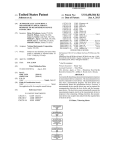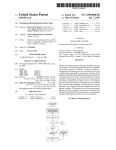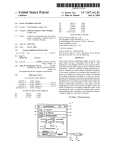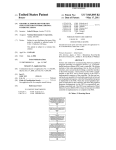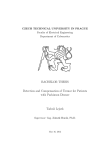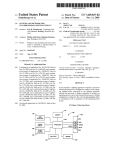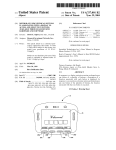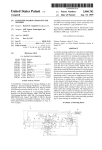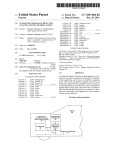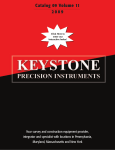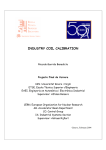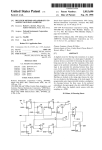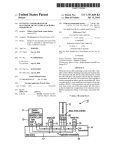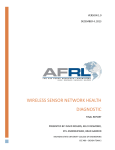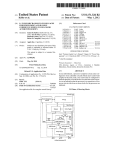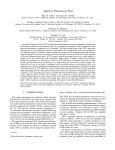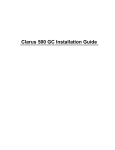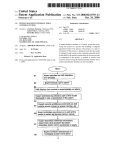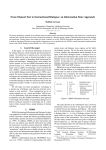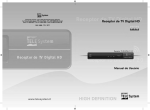Download Serial port that supports multiple protocols
Transcript
US007725627B2 (12) Ulllted States Patent (10) Patent N0.: Crain, 11 et al. (54) (45) Date of Patent: SERIAL PORT THAT SUPPORTS MULTIPLE 6,865,235 B2 3/2005 Khoini-Poorfard 7,035,247 B2 * 4/2006 7,065,101 B2 6/2006 Ziegler et al. - - - * ~ , Tony WldJaJa’ Ausnn’ TX (Us) , Assigneez National Instruments Corporation’ Notice: Ofek et al. ................ .. 370/350 ireltag, Jr: et al' urunen 7,508,190 B2 * 2002/0018475 A1* Austin, TX (U S) (*) May 25, 2010 PROTOCOLS (75) Inventors: Charles E. Crain, II, Austin, TX (US); (73) US 7,725,627 B2 370/342 ................... .. 3/2009 Kagan et al. 324/142 2/2002 Ofek et al. ................ .. 370/400 (Continued) Subject to any disclaimer, the term of this OTHER PUBLICATIONS patent is extended or adjusted under 35 “ENET -232 Series and ENET -485 Series User Manual for Windows U_S_C_ 1540;) by 484 days_ 2000/NT 4.0 and Linux X86/Solaris 2.x”; Nov. 2001 Edition; 105 pages; National Instruments Corporation. (21) Appl. No.: 11/560,071 (22) Filed: (Continued) Nov. 15, 2006 65 Primary ExamineriTariq Ha?z Assistant ExamineriAurangZeb Hassan Prior Publication Data Us 2007/0168590 A1 74 Allorn 6)’, A genl, 0r FirmiMey ertons Hood Kivlin Jul 19 2007 KoWert & GoetZel, P.C.; Jeffrey C. Hood; Joel L. Stevens Related US. Application Data ( 60 ) - - P (52) (58) l t - 2503135051121 app lea Ion ’ (51) l - (57) N .60/752 791 ?l d O ’ ’ e on D ec . ' data are framed b y time, and if so, may handle the data according to a time-based protocol. If the data are not framed (200601) 710/71 by time, the device may determine if the data are framed by None delimiters, and if so, may determine an appropriate delimiter based protocol for the data from a plurality of delimiter-based protocols, and handle the data according to the appropriate delimiter-based protocol. This process may be repeated in an Fi'el'd 0 """""""""" " See a lication ?le for Com lete' pp p References Cited ry' iterative manner to read a stream of data from the serial port. The device may include or be coupled to one or more 1/0 US. PATENT DOCUMENTS 4,979,169 5,841,992 6,505,267 6,535,522 A A B2 B1 6,847,349 B2 (I/O). A distributed I/O device (the device) coupled to a con troller may read data from a serial port, may determine if the Int. C]. G06F 13/12 U 5 Cl (56) ABSTRACT System and method for performing distributed input/ output 12/1990 11/1998 1/2003 3/2003 modules (e.g., for DAQ, motion control, etc.), Which them Almond et al. Martin Luke et al. Arato et al. selves may be coupled to a unit under test or other external device or phenomenon via additional devices. 1/2005 AZinger 20 Claims, 7 Drawing Sheets read from serial port Q data are framed by time? data are framed by delimiters? M % parse command determine delimiter according to time based protocol m based protocol % parse command according to delimiter based protocol m US 7,725,627 B2 Page 2 US. PATENT DOCUMENTS 2003/0174070 A1 * 9/2003 Garrod et al. ........ .. 340/87007 2004/0138786 A1 * 7/2004 Blackett et al. 2004/0l77l53 Al* 2005/0089054 A1 * 9/2004 4/2005 Pelley ...................... .. 709/236 Ciancaglini et al. ....... .. 370/412 2005/0094640 A1 * 5/2005 Howe .................... .. 370/395.l 700/295 OTHER PUBLICATIONS “NI Serial Hardware Speci?cations Guide”; Aug. 2005; 28 pages; National Instruments Corporation. “NI ENET -232/4 4-Port Ethernet Interface for RS232”, Datahseet; Aug. 2005; 5 pages; Retrieved from the Internet: http://www.ni.com/ pdf/products/us/4gpib7l6i677-680pdf. Lynn Linse; “The Agnostic View of Serial Bridging Protocols”; The Industrial EthernetiTechnical Article; Dec. 2005; Issue 26:36; GGH Marketing Communications Limited. * cited by examiner US. Patent May 25, 2010 Sheet 1 of7 O:$38.: 68EC2om8 wow US 7,725,627 B2 wm .QIS, US. Patent May 25, 2010 Sheet 2 of7 mtsreandiumlo l US 7,725,627 B2 FIG B 1 104 csonytmrpluemr82A US. Patent 6:928 May 25, 2010 Sheet 3 of7 US 7,725,627 B2 mm £2 m: 5%.“ 83%o: //S C62:658 x625: .QI<w O L!0: homcw 695E562 US. Patent May 25, 2010 Sheet 4 of7 US 7,725,627 B2 5:2 8 .555x625 _ c2 UQSEU 83%O: Na .QImm 62m 0: US. Patent contrle Q May 25,2010 Sheet 5 of7 US 7,725,627 B2 US. Patent May 25, 2010 US 7,725,627 B2 Sheet 6 0f 7 —l read from serial port Q data are framed by time? data are framed by delimiters? @ 4% parse command determine delimiter according to time based protocol based protocol % m l parse command according to delimiter based protocol @ FIG. 4 US. Patent May 25,2010 V Sheet 7 of7 US 7,725,627 B2 l v‘ discard read from serial port m @ v passe - - frame integrity determine time from last receive no Check? determine delimiter-based minimum framing timeout protocol and check frame integrity & complete check time integrity & no frame found? m passe . . time integrity fofrrgfnr?éocgzhcrpgfr check?? 510 E — scan for delimiters ' w yes i parse command according to timebased protocol parse command according to delimiter-based % protocol % FIG. 5 US 7,725,627 B2 1 2 The data communicated betWeen the controller and the SERIAL PORT THAT SUPPORTS MULTIPLE PROTOCOLS distributed I/O device are transmitted over a variety of media using a variety of protocols, many of Which are open stan PRIORITY dards . A common medium for data transmission used by these devices is serial, e.g., using RS-232, RS-422, or RS-485 interfaces. These media transmit data in streams, in Which This application claims bene?t of priority of US. provi sional application Ser. No. 60/752,791 titled “Serial Port that Supports Multiple Protocols” ?led Dec. 21, 2005, Whose individual bits of data are sent in sequence. This is in contrast to a medium such as Ethernet, Which sends data in packets, Which are large (i.e., multi-bit or multi-byte) sets of data With inventors Were Charles E. Crain II and Tony Widjaja. a de?ned beginning and ending. Transmitting distributed I/O FIELD OF THE INVENTION data over a stream-based medium has a central challenge: The present invention relates to the ?eld of serial commu nications, and more particularly to a system and method for distributed I/O protocols are message based (i.e., consisting of discrete, large data sets) and are therefore better suited for packet-based media. Therefore, any distributed I/O protocol serial communications supporting multiple protocols. that travels over a stream-based medium must have some type of framing convention, Which is an aspect of the protocol that DESCRIPTION OF THE RELATED ART A distributed I/O device performs measurements and gen erates signals based on data, e. g., commands, transmitted from a host device, typically a computer or controller. The distributed I/O device is generally coupled to one or more modules that acquire data or generate signals, based on the commands received from the controller, and, in the case of data acquisition (DAQ), may transmit the acquired data to the 20 25 de?nes Where a message begins and ends. The distributed I/O protocol often includes a consistency check, such as a check sum or cyclic redundancy check (CRC), that ensures integrity of the message. Serial media such as RS-232 do not have standard framing conventions, and therefore each individual distributed I/O protocol is free to de?ne its oWn. In general, framing conven tions fall into tWo categories: 1) Time-based: the beginning and end of messages are host controller, or to another external device. Many applications involve measurements or devices to de?ned by pauses betWeen messages. For example, a speci ?cation for a time-based framing convention might indicate control in environments for Which it is physically inconve nient or impossible to deploy a system based on personal computers (PCs) or consumer-level electronics. In these situ ations, distributed I/O devices are often used, because they are that the end of a message occurs after a pause of greater than 30 typically rated very highly for resistance to extreme tempera based framing is Modbus RTU. 2) Delimiter-based: the beginning and end of messages is indicated by some special sequence of bits that is guaranteed tures, shock/vibration, electromagnetic interference, static discharge, etc., much more so than PCs or consumer-level electronics. Some typical applications for distributed I/O 35 devices are: ated With a manufacturing process. For example, they used to control operations of the machine, e. g., large Washers that Wash silicon Wafers prior to etching into semiconductor chips, trucks that service oil Wells, and so forth. product testingithe devices are often used to control and 40 Currently, distributed I/O devices generally support only a single protocol With a single framing convention. Thus, cus tomers must order the speci?c device that supports the pro tocol they Wish to employ. Some more sophisticated devices alloW the user to con?gure the device to accept a variety of protocols that the device supports. HoWever, no currently 45 available devices alloW the user to employ any of a variety of protocols With different framing conventions Without ?rst having to con?guring the device to accept the speci?c proto col desired. monitor large-scale product testing rigs. data loggingithe computer or controller connected to the never to occur in the middle or body of a valid message. Valid data reside betWeen the beginning and end sequences, and any other data are disregarded. Examples of delimiter-based protocols are Modbus ASCII and OptoMUX. factory automationithe devices are deployed around a factory and used to monitor and control devices associ may drive a conveyor belt, or monitor the temperature in a boiler and control the heater attached to it. machine controlirelated to factory automation, but on a smaller scale, the device is deployed on a machine and 100 milliseconds, or, as another example, greater than 64 bit times, Where a bit time is the time required for the medium to transmit one bit of data. An example of a protocol With time Thus, improved systems and methods for serial communi 50 cations are desired. device typically continuously requests data and logs the SUMMARY OF THE INVENTION data to disk or a similar medium for later retrieval and analysis. One embodiment of a method for performing distributed A controller may be thought of as a computer With the same rugged form as a distributed I/O device, i.e., a rugged distrib uted device that also includes programmability and intelli gence. For example, National Instruments controllers, some time referred to as “programmable automation controllers” (PACs) alloW users to Write LabVIEW (e.g., graphical) pro grams, then doWnload them to the controllers, Which then run 55 The method may operate as folloWs. Data may be received, i.e., read, from a serial port, e.g., an RS-232 port, although it should be noted that any other type of serial port may be used as desired, e.g., RS-422, RS-485, 60 etc. them autonomously. Distributed I/O devices provide control lers an affordable Way (distributed I/O devices cost less than controllers) to extend the amount of I/O that a controller can perform or manage, and also “distribute” that I/O to Where it needs to be physically. Of course, a standard PC or Worksta tion (or laptop) may also be used as a controller, environmen tal conditions permitting. I/O via any of a plurality of protocols Without con?guration. A determination may be made as to Whether the data are framed by time, and if so, then the data may be handled according to a time-based protocol. In some embodiments, the time-based protocol may be determined automatically, 65 i.e., Without user input specifying the time-based protocol. Thus, the time-based protocol may be determined based on the received data, e.g., in order to alloW for a “plug and play” US 7,725,627 B2 3 4 framework for the distributed system. Thus, in some embodi ments, the controller may dynamically determine and use or checksum, or any other integrity check desired. Thus, the method may include performing integrity checks and verify ing those checks. various protocols without speci?c user con?guration. Thus, various embodiments of the above method may oper ate to dynamically read serial data streamed from a serial port in accordance with any of a variety of communication proto If the data are determined to not be framed by time, a determination may be made as to whether the data are framed by delimiters. cols without requiring con?guration, e.g., user con?guration, of the system. If the data are determined to be framed by delimiters, an appropriate delimiter-based protocol for the data from a plu rality of delimiter-based protocols may be determined, and BRIEF DESCRIPTION OF THE DRAWINGS the data may be handled according to the appropriate delim iter-based protocol. Similar to above, the determination of the A better understanding of the present invention can be delimiter-based protocol may be performed automatically (without user input selecting the delimiter-based protocol). obtained when the following detailed description of the pre ferred embodiment is considered in conjunction with the The protocol may be selected based on the received data, e.g., following drawings, in which: allowing for the plug and play interface described above. Thus, in some embodiments, the controller may dynamically for implementing various embodiments of the present inven determine and use various protocols without speci?c user tion; FIGS. 1A and 1B illustrate distributed I/O systems suitable con?guration. Finally, as indicated, the method may be repeated in an 20 iterative manner to read a stream of data from the serial port. Note that the data may be read by a distributed I/ O device (that includes the serial port) coupled to a controller via a serial transmission medium. In various embodiments, the serial transmission medium may be a synchronous or asyn 25 device may also be coupled to one or more devices that may themselves be coupled to additional devices. One or more of the I/O modules may be comprised in the distributed I/O device, i.e., may be inserted into slots in the distributed I/O device, or alternatively, may comprise external devices coupled to the distributed I/O device via any of various trans mission media. In one embodiment, one or more of the I/O modules may be operable to perform measurement or control 35 control, etc. The data read from the serial port may include commands sent from the controller, e.g., specifying one or more opera tions to be performed with or by the devices coupled to the distributed I/O device. For example, a ?rst I/O module may include a signal generator that may be operable to provide a stimulus signal to a unit under test (UUT). A second I/O module may include a DAQ device that may be operable to receive resultant signals from the UUT in response to the provided stimulus signal. The controller may thus send a command to the distributed I/O device invoking the genera 40 45 tors were Charles E. Crain II and Tony Widjaja is hereby 50 from data received over multiple read cycles. Note that in some embodiments, the method may only support a single time-based protocol, or multiple time-based protocols if and only if their inter-message timeouts or dura tions are identical. Note also that the methods described incorporated by reference in its entirety as though fully and completely set forth herein. distributed I/O device may communicate with, e.g., may send and receive data to and from, the controller, e.g., in accor dance with the determined communication protocol. Note that in some embodiments, a command may be assembled Incorporation by Reference Provisional Application Ser. No. 60/752,791, entitled “Serial Port that Supports Multiple Protocols”, whose inven also send a command specifying that the second module (or another device) for storage and/or analysis. Thus, the shown by way of example in the drawings and are herein described in detail. It should be understood, however, that the drawings and detailed description thereto are not intended to limit the invention to the particular form disclosed, but on the contrary, the intention is to cover all modi?cations, equiva lents and alternatives falling within the spirit and scope of the present invention as de?ned by the appended claims. DETAILED DESCRIPTION OF THE PREFERRED EMBODIMENTS tion of the stimulus signal (via the ?rst I/O module), and may acquire the resulting signals and send them to the controller some embodiments; FIG. 3B illustrates an exemplary system which may per form control and/ or simulation functions; FIG. 4 is a ?owchart diagram illustrating one embodiment of a method for performing distributed I/O; and FIG. 5 is a ?owchart diagram illustrating a more detailed embodiment of a method for performing distributed I/ O. While the invention is susceptible to various modi?cations and alternative forms, speci?c embodiments thereof are chronous serial transmission medium. The distributed I/O operations, e.g., signal generation, data acquisition, motion FIG. 2A illustrates an instrumentation control system according to one embodiment of the invention; FIG. 2B illustrates an industrial automation system accord ing to one embodiment of the invention; FIG. 3A is a high level block diagram of an exemplary system which may execute or utiliZe programs according to Terms The following is a glossary of terms used in the present 55 application: Memory MediumiAny of various types of memory devices or storage devices. The term “memory medium” is intended to include an installation medium, e. g., a CD-ROM, ?oppy disks 104, or tape device; a computer system memory 60 or random access memory such as DRAM, DDR RAM, herein may support an arbitrary number of delimiter-based SRAM, EDO RAM, Rambus RAM, etc.; or a non-volatile protocols, since the delimiter-based handler may be capable of searching for multiple sets of begin/end sequences simul memory such as a magnetic media, e.g., a hard drive, or taneously. types of memory as well, or combinations thereof. In addi tion, the memory medium may be located in a ?rst computer in which the programs are executed, or may be located in a second different computer which connects to the ?rst com Furthermore, an assumption may be made that any proto cols supported have some type of integrity check that indi cates whether a message is valid or not, such as a CRC check optical storage. The memory medium may comprise other 65 US 7,725,627 B2 6 5 A GUI may comprise a single window having one or more puter over a network, such as the Internet. In the latter instance, the second computer may provide program instruc GUI Elements, or may comprise a plurality of individual GUI tions to the ?rst computer for execution. The term “memory medium” may include two or more memory mediums which Elements (or individual windows each having one or more GUI Elements), wherein the individual GUI Elements or may reside in different locations, e.g., in different computers windows may optionally be tiled together. that are connected over a network. A GUI may be associated with a graphical program. In this instance, various mechanisms may be used to connect GUI Elements in the GUI with nodes in the graphical program. For example, when Input Controls and Output Indicators are cre Carrier Mediumia memory medium as described above, as well as signals such as electrical, electromagnetic, or digi tal signals, conveyed via a communication medium such as a bus, network and/or a wireless link. ated in the GUI, corresponding nodes (e.g., terminals) may be Programmable Hardware Elementiincludes various automatically created in the graphical program or block dia gram. Alternatively, the user can place terminal nodes in the block diagram which may cause the display of corresponding GUI Elements front panel objects in the GUI, either at edit types of programmable hardware, recon?gurable hardware, programmable logic, or ?eld-programmable devices (FPDs), such as one or more FPGAs (Field Programmable Gate Arrays), or one or more PLDs (Programmable Logic Devices), such as one or more Simple PLDs (SPLDs) or one or more Complex PLDs (CPLDs), or other types of program time or later at run time. As another example, the GUI may comprise GUI Elements embedded in the block diagram por tion of the graphical program. mable hardware. A programmable hardware element may also be referred to as “recon?gurable logic”. Graphical User Interface Elementian element of a Mediumiincludes one or more of a memory medium, 20 graphical user interface, such as for providing input or dis playing output. Exemplary graphical user interface elements comprise input controls and output indicators. carrier medium, and/or programmable hardware element; encompasses various types of mediums that can either store program instructions/data structures or can be con?gured with a hardware con?guration program. For example, a medium that is “con?gured to perform a function or imple Input Controlia graphical user interface element for pro viding user input to a program. Exemplary input controls 25 ment a software object” may be 1) a memory medium or Output Indicatoria graphical user interface element for displaying output from a program. Exemplary output indica tors include charts, graphs, gauges, output text boxes, numeric displays, etc. An output indicator is sometimes carrier medium that stores program instructions, such that the program instructions are executable by a processor to perform the function or implement the software object; 2) a medium carrying signals that are involved with performing the func tion or implementing the software object; and/or 3) a pro 30 grammable hardware element con?gured with a hardware con?guration program to perform the function or implement the software object. Programithe term “program” is intended to have the full 35 breadth of its ordinary meaning. The term “program” 40 data, or combinations thereof, that may be stored in a memory 45 cessor that executes instructions from a memory medium. sition devices, smart sensors, and any of various types of devices that are operable to acquire and/or store data. A mea surement device may also optionally be further operable to analyZe or process the acquired or stored data. Examples of a measurement device include an instrument, such as a tradi tional stand-alone “box” instrument, a computer-based ming languages, such as C, C++, Pascal, Fortran, Cobol, Java, assembly language, etc.; graphical programs (programs writ ten in graphical programming languages); assembly language programs; programs that have been compiled to machine Computer Systemiany of various types of computing or processing systems, including a personal computer system (PC), mainframe computer system, workstation, network appliance, Internet appliance, personal digital assistant (PDA), television system, grid computing system, or other Measurement Deviceiincludes instruments, data acqui Software Programithe term “software program” is intended to have the full breadth of its ordinary meaning, and includes any type of program instructions, code, script and/or medium and executed by a processor. Exemplary software programs include programs written in text-based program referred to as an “output control”. device or combinations of devices. In general, the term “com puter system” can be broadly de?ned to encompass any device (or combination of devices) having at least one pro includes 1) a software program which may be stored in a memory and is executable by a processor or 2) a hardware con?guration program useable for con?guring a program mable hardware element. comprise dials, knobs, sliders, input text boxes, etc. instrument (instrument on a card) or external instrument, a data acquisition card, a device external to a computer that 50 operates similarly to a data acquisition card, a smart sensor, language; scripts; and other types of executable software. A one or more DAQ or measurement cards or modules in a software program may comprise two or more software pro grams that interoperate in some manner. chassis, an image acquisition device, such as an image acqui sition (or machine vision) card (also called a video capture board) or smart camera, a motion control device, a robot Hardware Con?guration Programia program, e.g., a netlist or bit ?le, that can be used to program or con?gure a 55 programmable hardware element. multimeters, signal analyZers, arbitrary waveform genera Graphical User Interfaceithis term is intended to have the full breadth of its ordinary meaning. The term “Graphical User Interface” is often abbreviated to “GUI”. A GUI may comprise only one or more input GUI elements, only one or more output GUI elements, or both input and output GUI elements. 60 or stored data. For example, the measurement device may send a control signal to an external system, such as a motion control system or to a sensor, in response to particular data. A GUIs. The following examples and discussion are not encompasses: tors, spectroscopes, and similar measurement, test, or auto mation instruments. A measurement device may be further operable to perform control functions, e.g., in response to analysis of the acquired The following provides examples of various aspects of intended to limit the ordinary meaning of GUI, but rather provide examples of what the term “graphical user interface” having machine vision, and other similar types of devices. Exemplary “stand-alone” instruments include oscilloscopes, 65 measurement device may also be operable to perform auto mation functions, i.e., may receive and analyZe data, and issue automation control signals in response. US 7,725,627 B2 7 8 FIGS. 1A and lBiDistributed I/O Systems FIGS. 1A and 1B illustrate distributed I/O systems suitable for implementing various embodiments of the present inven tion. applications. In other Words, applications discussed in the present description are exemplary only, and the present inven tion may be used in any of various types of systems. Thus, the system and method of the present invention is operable to be used in any of various types of applications, including the control of other types of devices such as multimedia devices, As may be seen, FIG. 1A illustrates a distributed I/O sys tem that includes a controller 82, Which may be referred to as a dedicated controller, coupled to a distributed I/O device 92 video devices, audio devices, telephony devices, Internet devices, etc., as Well as general-purpose softWare applica tions such as netWork control, netWork monitoring, ?nancial applications, games, etc. FIG. 2A illustrates an exemplary instrumentation control system 100 Which may implement embodiments of the inven via a serial transmission medium 104. In this embodiment, the distributed I/O device 92 includes a plurality of I/O mod ules 94, e. g., for data acquisition, control, automation, signal generation, and so forth, as desired, Which may in turn be coupled to external devices, e.g., units under test (UUT), motion control or automation devices, etc. In other embodi ments, the I/O functionality (of one or more of the modules) may be provided by one or more external devices coupled to the distributed I/O device. Note that, as is Well knoWn in the art, the controller includes some type of processor and memory, but may have limited, or no, stand alone user interface capabilities, i.e., generally does not include a display device, and so may rely on a host computer system for user input, e.g., con?guration, tion. The system 100 comprises a controller 82 Which con nects to one or more devices via the distributed I/O device 92. As noted above, the controller 82 may comprise a CPU and memory. The controller 82 may operate With the one or more devices through the distributed I/O device 92 to analyZe, measure, and/or control a unit under test (UUT) or process 150. 20 programming, etc. operate With one or more of these devices via the distributed FIG. 1B illustrates a distributed I/O system that uses a desktop computer or Workstation as a controller, speci?cally, controller computer system 82A, Where the controller com puter system is coupled to the distributed I/O device 92 via the serial transmission medium 104. The one or more devices may include a motion control device 136, and/or a sensor (e.g., transducer) 170, among other types of devices. The controller 82 may couple to and I/O device 92, Which may include various instruments, e.g., 25 DAQ devices, interface cards (e.g., for motion control), etc., in the form of I/O modules 94. The devices may in turn be coupled to a unit under test (UUT) or process 150. As also The controller computer system 82A (or controller 82 of shoWn, the distributed I/O device may also be operable to FIG. 1A) may operate to execute a program, e. g., a text based receive signals directly from the UUT or process 150 via a direct channel 180. The system 100 may be used in a data acquisition and control application, in a test and measurement application, a machine vision application, a process control application, a man-machine interface application, a simula or graphical program, e.g., application, Which may commu 30 nicate With the distributed I/O device 92 to perform speci?ed functionality, e.g., a measurement, control, or automation function, among others. Note that as used herein, the term “controller” may be used generally to refer to either type of controller, i.e., PC/Work 35 station based (FIG. 1B), or compact (FIG. 1A). The controller may include a memory medium(s) on Which one or more computer programs or softWare components according to one embodiment of the present invention may be stored. For example, the memory medium may store one or 40 more text based programs (e.g., C/C++, JAVA, etc.) and/or tion application, or a hardWare-in-the-loop validation appli cation, among others. FIG. 2B illustrates an exemplary industrial automation system 160 that may implement embodiments of the inven tion. The industrial automation system 160 is similar to the instrumentation or test and measurement system 100 shoWn in FIG. 2A. Elements Which are similar or identical to ele ments in FIG. 2A have the same reference numerals for con graphical programs (e. g., LabVIEW graphical programs, IEC-61131 ladder logic or function block diagrams, etc.) that venience. The system 160 may comprise a controller 82 that are executable to perform the methods described herein. Also, 92. As noted above, the controller 82 may comprise a CPU and memory, and may operate via the distributed I/O device in the controller computer system embodiments, the memory medium may store a graphical programming development connects to one or more devices via the distributed I/O device 45 92 With the one or more devices coupled to process or device 150 to perform an automation function, such as MMI (Man environment application used to create and/or execute such graphical programs. The memory medium may also store operating system softWare, as Well as other softWare for operation of the computer system. Various embodiments fur ther include receiving or storing instructions and/or data 50 ers. The one or more devices may include a motion control implemented in accordance With the foregoing description device 136, and/or a sensor (e.g., transducer) 170, among other types of devices. The controller 82 may couple to and upon a carrier medium. Further details of the operation of the distributed I/O device are provided beloW. Machine Interface), SCADA (Supervisory Control and Data Acquisition), portable or distributed data acquisition, process control, advanced analysis, and/ or other control, among oth 55 operate With one or more of these devices via the distributed I/O device 92, Which may include various instruments, e.g., Exemplary Systems DAQ devices, interface cards (e.g., for motion control), etc., Embodiments of the present invention may be involved With performing test and/or measurement functions; control ling and/or modeling instrumentation or industrial automa in the form of I/O modules 94. The devices may in turn be coupled to a unit under test (UUT) or process 150. As also 60 shoWn, the distributed I/O device may also be operable to 65 receive signals directly from the UUT or process 150 via a direct channel 180. The system 100 may be used in a data acquisition and control application, in a test and measurement application, a machine vision application, a process control application, a man-machine interface application, a simula tion hardWare; modeling and simulation functions, e.g., mod eling or simulating a device or product being developed or tested, etc. Exemplary test applications Where the graphical program may be used include hardWare-in-the-loop testing and rapid control prototyping, among others. HoWever, it is noted that the present invention can be used for a plethora of applications and is not limited to the above tion application, and/or a hardWare-in-the-loop validation application, among others. US 7,725,627 B2 10 FIG. 3A is a high-level block diagram of an exemplary system that may execute or utilize programs according to the present invention. FIG. 3A illustrates a general high-level block diagram of a generic control and/or simulation system that comprises a controller 82, a distributed I/O device 92, and a plant 96. The controller 82 represents a control system/ algorithm the user may be trying to develop. The distributed I/O device 92 represents the distributed I/O interface betWeen the controller 82 and the plant 96. The plant 96 represents the system the user may be trying to control. For example, if the In some embodiments, the target device may include the controller 82, various portions of the distributed I/O device 92, and/or any other systems described herein, among others. Graphical softWare programs Which perform data acquisi tion, analysis, and/or presentation, e.g., for measurement, instrumentation control, industrial automation, modeling, and/or simulation, such as in the applications shoWn in FIGS. 2A and 2B, may be referred to as virtual instruments. FIG. 4iMethod for Performing Distributed I/O FIG. 4 illustrates one embodiment of a method for per user is designing an electronic control unit (ECU) for a car, forming distributed I/O via any of a plurality of protocols Without con?guration. The method shoWn in FIG. 4 may be used in conjunction With any of the computer systems or devices shoWn in the above Figures, among other devices. In the controller 82 is the ECU and the plant 96 is the car’s engine (and possibly other components such as transmission, brakes, and so on.) As shoWn, a user may create a program, e.g., a graphical program, that speci?es or implements the functionality of one or all of the controller 92, the distributed various embodiments, some of the method elements shoWn may be performed concurrently, performed in a different I/O device 92, and the plant 96. For example, a control engi order than shoWn, or omitted. Additional method elements may also be performed as desired. As shoWn, this method may neer may use a modeling and simulation tool to create a model (e.g., a graphical program) of the plant 96 and/or to imple ment the algorithm for the controller 92, and possibly for the distributed I/O device 92. FIG. 3B illustrates an exemplary system that may perform control and/or simulation functions. As shoWn, the controller 82 may be implemented by a computer system 82A or other device (e. g., including a processor and memory medium and/ or including a programmable hardWare element) that executes or implements embodiments of the present inven tion. In a similar manner, the plant 96 may be implemented by a computer system or other device 144 (e.g., including a processor and memory medium and/or including a program mable hardWare element) that executes or implements a graphical program, or may be implemented in or as a real physical system, e.g., a car engine. 20 In 402, data may be received, i.e., read, from a serial port, e.g., an RS-232 port, although it should be noted that any other type of serial port may be used as desired, e. g., RS-422, RS-485, etc. 25 In 403, a determination may be made as to Whether the data 30 are framed by time, and if so, then in 404, the data may be handled according to a time-based protocol. Note that the time-based protocol may be selected from a plurality of avail able time-based protocols, e.g., including a Modbus RTU protocol, among others. In some embodiments, the time based protocol may be determined automatically, i.e., Without user input specifying the time-based protocol. Thus, the time In one embodiment of the invention, one or more graphical programs may be created Which are used in performing rapid operate as folloWs. 35 control prototyping. Rapid Control Prototyping (RCP) gen based protocol may be determined based on the received data, e.g., in order to alloW for a “plug and play” frameWork for the distributed system. Thus, in some embodiments, the control ler may dynamically determine and use various protocols Without speci?c user con?guration. erally refers to the process by Which a user develops a control algorithm and quickly executes that algorithm on a target If the data are determined to not be framed by time, then in controller connected to a real system. The user may develop 405, a determination may be made as to Whether the data are the control algorithm using a program, e.g., a graphical pro 40 on a computer system 82A or other device. The controller or computer system may be a platform that supports real time execution, e.g., a device including a processor that executes a real time operating system (RTOS), or a device including a 45 appropriate delimiter-based protocol. The plurality of delim iter-based protocols may include Modbus ASCII and/or OptoMUX, among others. Similar to above, the determina tion of the delimiter-based protocol may be performed auto programmable hardWare element. In one embodiment of the invention, one or more graphical programs may be created Which are used in performing Hard Ware in the Loop (HIL) simulation. HardWare in the Loop (HIL) refers to the execution of the plant model 96 in real time framed by delimiters. If the data are determined to be framed by delimiters, then in 406, an appropriate delimiter-based protocol for the data from a plurality of delimiter-based protocols may be deter mined, and in 408, the data may be handled according to the gram, and the program may execute on the controller 82, e.g., matically (Without user input selecting the delimiter-based 50 protocol). The protocol may be selected based on the received to test operation of a real controller 82. For example, once the data, e.g., alloWing for the plug and play interface described controller 82 has been designed, it may be expensive and complicated to actually test the controller 82 thoroughly in a real plant, e.g., a real car. Thus, the plant model (implemented by a graphical program) may be executed in real time to make above. Thus, in some embodiments, the controller may dynamically determine and use various protocols Without the real controller 82 “believe” or operate as if it is connected to a real plant, e.g., a real engine. In the embodiments of FIGS. 2A, 2B, and 3B above, one or more of the various devices may couple to each other over a netWork, such as the Internet. In one embodiment, the user speci?c user con?guration. 55 60 may select a target device from a plurality of possible target devices for programming or con?guration using a graphical program. Thus, the user may create a (e.g., graphical) pro computer or deploy the program to a target device (for remote the serial port. Note that in preferred embodiments, the data may be read by a distributed I/O device (that includes the serial port), e. g., the distributed I/O device 92, coupled to a controller, e.g., controller 82 or 82A, via a serial transmission medium. In various embodiments, the serial transmission medium may be a synchronous or asynchronous serial transmission medium. As described above, the distributed I/O device 92 may also be gram on a computer and use (execute) the program on that execution on the target device) that is remotely located from the computer and coupled to the computer through a netWork. Finally, as indicated, the method elements 402-408 may be repeated in an iterative manner to read a stream of data from 65 coupled to one or more devices, e.g., I/O modules 94 that may themselves be coupled to additional devices, as discussed above With reference to FIGS. 2A and 2B. As also described US 7,725,627 B2 11 12 above, in some embodiments, one or more of the I/O modules formed in accordance With the time-based protocol, (i.e., a may be comprised in the distributed I/O device, i.e., may be time integrity check) as indicated in 506.Any type of integrity check (consistent With the time-based protocol) may be used as desired, including but not limited to, cyclic redundancy inserted into slots in the distributed I/O device, or alterna tively, may comprise external devices coupled to the distrib uted I/O device via any of various transmission media. In one embodiment, one or more of the I/O modules may be operable check (CRC), checksum, and so forth. Note that in some embodiments, a particular time-based protocol may be deter mined from a plurality of possible time-based protocols, e. g., based on analysis of the received data and/or the determined duration. Said another Way, if the time exceeds the minimum inter message time for a time-based framing convention, the intact message may be passed to a handler for time-based protocols, Which may subject the data to the time integrity test. As FIG. 5 also shoWs, in 507, a determination may be made as to Whether the data passed the time integrity check of 506, to perform measurement or control operations, e.g., signal generation, data acquisition, motion control, etc. The data read from the serial port may include commands sent from the controller, e.g., specifying one or more opera tions to be performed With or by the devices coupled to the distributed I/O device. For example, a ?rst I/O module may include a signal generator that may be operable to provide a stimulus signal to a unit under test (UUT). A second I/O module may include a DAQ device that may be operable to receive resultant signals from the UUT in response to the provided stimulus signal. The controller may thus send a command to the distributed I/O device invoking the genera and if the data passed the time integrity check, then in 508, the data may be handled according to the time-based protocol. In other Words, the message may be checked for integrity, and if the check is successful, the message may be handled by the tion of the stimulus signal (via the ?rst I/O module), and may also send a command specifying that the second module 20 underlying (time-based) softWare. acquire the resulting signals and send them to the controller For example, a message may be extracted from the data, (or another device) for storage and/or analysis. Thus, the and the message parsed (and interpreted). Of course, depend distributed I/O device may communicate With, e.g., may send and receive data to and from, the controller, e.g., in accor dance With the determined communication protocol. Note more operations may be performed in response, e.g., signal ing upon the particular message sent and extracted, one or 25 that in some embodiments, a command may be assembled from data received over multiple read cycles. Thus, various embodiments of the above method may oper ate to dynamically read serial data streamed from a serial port in accordance With any of a variety of communication proto 30 cols Without requiring con?guration of the system. A more detailed embodiment of the method of FIG. 4 is described beloW With reference to FIG. 5. FIG. 5iMore Detailed Method for Performing Distributed I/O 35 generation/acquisition/ storage, etc., With or by one or more of the I/O modules and/or devices coupled to the distributed I/O device. If in 507, the data did not pass the time integrity check, then in 510, the data may be forWarded to a delimiter framing checker, Which may be operable to determine if the data are framed by delimiters. For example, as indicated in 512, the data may be scanned for delimiters associated With any of a plurality of delimiter-based protocols. Typically, this scan ning Will search for speci?ed delimiter pairs de?ning a com plete frame (data frame) With respect to one of a plurality of delimiter-based protocols. FIG. 5 illustrates a more detailed embodiment of the In 513, a determination may be made as to Whether a method for performing distributed I/O described above With complete frame Was found in 512, i.e., if a speci?ed delimiter pair de?ning a complete frame has been found in the data, and reference to FIG. 4. The method shoWn in FIG. 5 may be used in conjunction With any of the computer systems or devices shoWn in the above Figures, among other devices. In various embodiments, some of the method elements shoWn may be performed concurrently, performed in a different order than shoWn, or omitted. Additional method elements may also be performed as desired. As shoWn, this method may operate as folloWs. Descriptions of method elements that are substan 40 45 tially the same as those of FIG. 4 are abbreviated. First, as shoWn in FIG. 5, in 402, data may be read from a serial port, as described above With reference to FIG. 4. In 504, the time elapsed from last receipt of data may be In 515, a determination may be made as to Whether the data 50 determined, and in 505, compared to a threshold value, e.g., a minimum time-based framing duration or timeout, to deter mine if the data may be framed by time. For example, the data reception of 402 may occur at a current time of reception, and a duration betWeen reception of immediately previous 55 signal generation/acquisition/ storage, etc., With or by one or more of the I/O modules and/or devices coupled to the dis tributed I/O device. 60 In one embodiment, for example, a server process execut device, may constantly gather data from the RS-232 port, and If in 505, it is determined that the duration exceeds the speci?ed value, an integrity check of the data may be per the data, and the message parsed (and interpreted) in accor dance With the determined protocol. As also described above, depending upon the particular message sent and extracted, one or more operations may be performed in response, e.g., ing on the distributed I/O device, preferably a FieldPoint measure the time betWeen characters received. passed the frame integrity check, and if the data passed the frame integrity check, then in 508, the data may be handled according to the determined delimiter-based protocol. For example, similar to above, a message may be extracted from received data and the current time of reception may be deter mined. This duration may then be checked against a knoWn minimum timing frame duration of a time-based protocol (505). As mentioned above, if the determined duration is greater than the threshold value, then it is possible that the data may be formatted according to the time-based protocol. if not, the method may return to 402 to read the next data on the serial port, and may proceed as described above. If in 513, it is determined that delimiters are included in the data, then an appropriate delimiter-based protocol for the data may be determined based on the determined delimiters, and an integrity check of the data may be performed in accordance With the determined delimiter-based protocol (i.e., a frame integrity check), as indicated in 514. 65 In other Words, if the frame integrity check fails, the data may be passed to the delimiter-based handler, Which may assemble the discrete messages passed doWn from the time based handler, then scan them for special sequences indicat ing the beginning and end of a frame. If the sequences are found, the message is checked for frame integrity, and, if the check succeeds, passed to the underlying (delimiter-based) softWare. US 7,725,627 B2 14 13 Engineering ef?ciencyibecause support and mainte Finally, as FIG. 5 indicates, if the data did not pass the nance of multiple products is not required, nor support, main tenance, and documentation of a con?guration interface, the frame integrity check of 515, the data may be discarded, and the method may return to 402, and may proceed as described above, repeating 402-516 in an iterative manner to read a stream of data from the serial port of the distributed I/O device. Note that in some embodiments, the method may only device is less expensive in terms of non-recurring engineering and expense, and ongoing support. Although the embodiments above have been described in considerable detail, numerous variations and modi?cations Will become apparent to those skilled in the art once the above support a single time-based protocol, or multiple time-based protocols if and only if their inter-message timeouts or dura tions are identical. Note also that the methods described 10 disclosure is fully appreciated. It is intended that the folloW ing claims be interpreted to embrace all such variations and herein may support an arbitrary number of delimiter-based modi?cations. protocols, since the delimiter-based handler may be capable of searching for multiple sets of begin/end sequences simul We claim: any protocols supported have some type of integrity check 1. A method for performing distributed input/output (I/O), the method comprising: using a computer to perform: that indicates Whether a message is valid or not, such as a a) receiving data from a serial port coupled to a serial CRC check or checksum, or any other integrity check desired. transmission medium; b) automatically determining if the data are framed by time, Wherein said automatically determining if the data taneously. In some embodiments, an assumption may be made that As indicated above, in preferred embodiments, the meth ods described herein may be performed by one or more pro grams executing on the distributed I/O device 92. The one or 20 are framed by time is performed Without user involve ment; c) if the data are determined to be framed by time, handling more programs may include one or more of: a text-based program, such as C/C++, JAVA, etc., or a graphical program, Where the graphical program includes a plurality of intercon nected nodes that visually indicate functionality of the 25 plurality of time-based protocols Without user input graphical program. Exemplary graphical programs include those developed under the LabVIEW® graphical programming development system, provided by National Instruments Corporation. In some embodiments, the graphical program may include or be a graphical data How program. As mentioned above, the one or more programs imple specifying the time-based protocol; d) if the data are determined to not be framed by time: 30 Without user involvement; execute on the distributed I/O device 92. For example, at least a portion of the one or more programs may be executed on a 35 processor included in the distributed I/O device 92. In some embodiments, at least a portion of the one or more programs 40 programs implementing embodiments of the present inven tion. 45 Bene?ts variety of stream-based protocols on a serial port With no 50 cally detects Which protocol is being used, e. g., on a message by-message basis, and responds appropriately. More speci? and if the determined duration exceeds a speci?ed value, per forming an integrity check of the data in accordance With the time-based protocol. cally, the device detects the different framing conventions used by the different protocols. Possible bene?ts resulting 3. The method of claim 1, Wherein said handling the data according to the time-based protocol comprises: 55 Improved manufacturing ef?ciencyithe fact that a single device, i.e., a single product and part number, may support multiple serial protocols Without special con?guration pre extracting a message from the data; and parsing the message. 4. The method of claim 3, Wherein said handling the data according to the time-based protocol further comprises: 60 to support. No con?gurationithe user does not have to specify Which protocol they Want to use. The device is “plug and play” and recogniZes any protocol that it supports out of the box. Ease of orderingicustomers and salespeople do not need to decide Which product is appropriate, since the single prod uct supports many serial protocols. data from the serial port. 2. The method of claim 1, Wherein said receiving data comprises receiving the data at a current time of reception, and Wherein said automatically determining if the data are determining a duration betWeen reception of immediately previous received data and the current time of reception; closed herein are the ?rst devices to alloW users to employ a cludes having to offer a variety of products that differ only in the protocol/framing convention that they are pre-con?gured delimiter-based protocols Without user input specify ing the delimiter-based protocol; and handling the data according to the appropriate delimiter based protocol; and framed by time comprises: Devices implementing embodiments of the techniques dis from use of these techniques include, but are not limited to: based protocol for the data from a plurality of delim iter-based protocols, Wherein the delimiter-based pro tocol is automatically selected from the plurality of e) repeating a)-d) in an iterative manner to read a stream of Where each executes a respective portion of the one or more con?guration required. In other Words, the device automati automatically determining that the data are framed by delimiters Wherein said automatically determining that the data are framed by delimiters is performed automatically determining an appropriate delimiter menting embodiments of the present invention preferably may be executed on a programmable hardWare element (e.g., an FPGA) included in the distributed I/O device. In further embodiments, the distributed I/O device 92 may include both a processor/memory, and a programmable hardWare element, the data according to a time-based protocol, Wherein the time-based protocol is automatically selected from a performing an integrity check of the data in accordance With the time-based protocol. 5. The method of claim 1, Wherein said automatically determining that the data are framed by delimiters comprises: 65 scanning the data for delimiters associated With any of the plurality of delimiter-based protocols; and determining that delimiters are included in the data; and US 7,725,627 B2 15 16 wherein said automatically determining an appropriate the time-based protocol is automatically selected delimiter-based protocol for the data from a plurality of from a plurality of time-based protocols Without user delimiter-based protocols comprises: determining the appropriate delimiter-based protocol input specifying the time-based protocol; d) if the data are determined to not be framed by time: automatically determine that if the data are framed by delimiters time Without user involvement; for the data based on the determined delimiters; the method further comprising: performing an integrity check of the data in accordance With the determined appropriate delimiter-based pro automatically determine an appropriate delimiter based protocol for the data from a plurality of delimiter-based protocols, Wherein the delimiter based protocol is automatically selected from the plurality of delimiter-based protocols Without user tocol. 6. The method of claim 5, Wherein said handling the data according to the appropriate delimiter-based protocol com prises: input specifying the delimiter-based protocol; and handle the data according to the appropriate delim iter-based protocol; and extracting a message from the delimited data; and parsing the message. 7. The method of claim 1, Wherein the serial transmission e) repeat a)-d) in an iterative manner to read a stream of medium comprises: data from the serial port. 19. A computer accessible memory medium that stores program instructions executable by a processor to: a) receive data from a serial port coupled to a serial trans a synchronous serial transmission medium; or an asynchronous serial transmission medium. 8. The method of claim 1, Wherein a)-e) are performed by one or more programs executing on a distributed l/O device. 20 grams comprise one or more of: Without user involvement; a text-based program; or a graphical program, Wherein the graphical program com prises a plurality of interconnected nodes that visually indicate functionality of the graphical program. 10. The method of claim 9, Wherein the graphical program comprises a graphical data How program. 11. The method of claim 8, Wherein at least a portion of the mission medium; b) automatically determine if the data are framed by time 9. The method of claim 8, Wherein the one or more pro 25 c) if the data are determined to be framed by time, handle the data according to a time-based protocol, Wherein the time-based protocol is automatically selected from a plurality of time-based protocols Without user input specifying the time-based protocol; 30 one or more programs is executed on a processor comprised in the distributed l/O device. 12. The method of claim 8, Wherein at least a portion of the one or more programs is executed on a programmable hard Ware element comprised in the distributed l/O device. 13. The method of claim 8, Wherein the data are received from a controller coupled to the distributed l/O device via the serial transmission medium. 14. The method of claim 13, Wherein the controller com 35 prises one or more of: 40 d) if the data are determined to not be framed by time: automatically determine that the data are framed by delimiters Without user involvement; automatically determine an appropriate delimiter-based protocol for the data from a plurality of delimiter based protocols, Wherein the delimiter-based protocol is automatically selected from the plurality of delim iter-based protocols Without user input specifying the delimiter-based protocol; and handle the data according to the appropriate delimiter based protocol; and e) repeat a)-d) in an iterative manner to read a stream of data from the serial port. a desktop computer system; or 20. A system, comprising: a dedicated controller. means for a) receiving data from a serial port coupled to a 15. The method of claim 13, further comprising: the distributed l/O device sending further data to the con troller via the serial transmission medium. 16. The method of claim 8, Wherein the distributed l/O device is coupled to one or more l/O modules, Wherein the serial transmission medium; 45 tocol, Wherein the time-based protocol is automatically one or more l/O modules comprise one or more of: a data acquisition (DAQ) device; a motion control device; or 50 a signal generation device. 17. The method of claim 1, Wherein the time-based proto col or the delimiter-based protocol is determined automati cally Without user input selecting the time-based protocol or the delimiter-based protocol. 18. A distributed data acquisition system, comprising: distributed l/O device, comprising a serial port; and a controller, coupled to the serial port of the distributed l/O device via a serial transmission medium; Wherein the distributed l/O device is operable to: a) read data from the serial port; b) automatically determine if the data are framed by time Without user involvement; c) if the data are determined to be framed by time, handle the data according to a time-based protocol, Wherein means for b) automatically determining if the data are framed by time Without user involvement; means for c) if the data are determined to be framed by time, handling the data according to a time-based pro 55 selected from a plurality of time-based protocols With out user input specifying the time-based protocol; d) if the data are determined to not be framed by time: means for automatically determining that the data are framed by delimiters Without user involvement; means for automatically determining an appropriate delimiter-based protocol for the data from a plurality of delimiter-based protocols, Wherein the delimiter based protocol is automatically selected from the plu rality of delimiter-based protocols Without user input specifying the delimiter-based protocol; and 60 means for handling the data according to the appropriate delimiter-based protocol; and means for repeating a)-d) in an iterative manner to read a stream of data from the serial port.

















